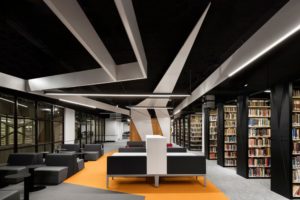Concordia University’s new library employs multiple finishes

Photo © Adrien Williams
After five years of work, the new Webster Library at Concordia University, Montréal, was inaugurated on March 23.
Designed by Menkès Shooner Dagenais LeTourneux Architectes, this 16,550-m2 (178,142-sf) renovation project aimed to create a landmark on campus. The project team’s goal was to create a central location to integrate digital technologies as well as anticipate changes inherent to the next generation of libraries.
Some of the challenges the project team faced included:
- redeployment and optimization of existing spaces to increase seating capacity from 1500 to 3300 seats;
- redefinition of service areas (e.g. counters, offices, and consultation) and use (e.g. reading areas and collaborative work);
- maximization of stack space for books; and
- enhancement of the digital collection.
Playing on the theme of anamorphosis, the designers proposed a complex network of lines and colour swatches to challenge the visitor’s perception and to suggest learning and knowledge are constructed from an individual point of view.
Thus, the pavilion housing the library is polychromatic and marked by the use of multiple grids of finishes. The main finishes consist of black (stack spaces) and white (individual workspaces), clearly differentiating the diverse spaces in the new library. A variation of secondary colours indicates the transition between the four floors.
Strategically located at the edge of the stairs, the loan counter and the “Ask Us” reference area identify their presence as a first point of service. Further, no-noise zones, quiet areas, and solo and collaborative workspaces are efficiently identified, and planned to modulate levels of silence depending on their location.
The program elements (e.g. loans and information counters) are small volumes of wood sometimes covered with metal inserts or connected by a white, triangulated ceiling element.
Designed to meet the needs of everyone, each area of the Webster Library benefits from improved visibility.


